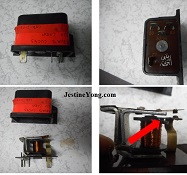How To Repair Automotive Relay

This automobile relay was brought to me and the complaint was the high beam (light) was not working.

The relay was opened up to check on any defect. As you can see in one of the photos above, the one with the red arrow, the plastic was deformed, and watch carefully the point of the red arrow: the black plastic tip could not fix into the hole in the metallic piece. I suppose the malfunction was due to an overheating.
Then I asked for the power of the bulbs used in that automobile: 2*60/55w (H4) + 2+55w (H1)
By taking into account Ohm’s Law we have:

Therefore I= P / V
For the 60/55 w bulb (H4) I = 60 / 12 = 5A x 2 bulbs I = 10 A
For the 55w bulb (H1) I = 55 / 12 = 4.6 A x 2 bulbs I = 9.2 A
Therefore 10 A + 9.2 A = 19.2 A
As you can see the total consumption is 19.2 A. Then I looked for in my spare and found two relays (recovered from unused Back Up UPS) of 10 A each one.

The old relay was mounted into a vice and with the help of a hacksaw blade the coil and the out-blade were cut.

Now it was really necessary to solder the new relays respecting the correct wiring.

The above image is taking into consideration the Standard DIN 72552.


The connections were soldered in parallel and the relay was tested with voltage.

Now the new relay are interconnected in the same box and prepared for functioning. By the way, the car relay is in use now and everything’s fine.

This article was prepared for you by Humberto Rodriguez, one of our ‘Master Authors’ from Cuba
Please give a support by clicking on the social buttons below. Your feedback on the post is welcome. Please leave it in the comments.
P.S- If you enjoyed reading this, click here to subscribe to my blog (free subscription). That way, you’ll never miss a post. You can also forward this website link to your friends and colleagues-thanks!
Relay related article:
https://jestineyong.com/servicing-relay/
https://jestineyong.com/nissan-pulsar-intermittent-wiper-relay-repaired/
https://jestineyong.com/bad-relay-found-in-kia-car-pride/
 (95)Dislikes
(95)Dislikes (1)
(1)






Parasuraman S
August 1, 2016 at 12:55 pm
Very nice!
Humberto
August 4, 2016 at 10:53 pm
Thanks Parasuraman S
Waleed
August 1, 2016 at 3:07 pm
very creative but with all due respect my friend, a relay like that is very very easy to find..why go through this trouble when you can install a new fresh one already made. thanks
Humberto
August 4, 2016 at 10:56 pm
Yes Waleed, maybe in your country and in some other part of the world is very easy to find it, but remember in Cuba, my native country, is very difficult to find this kind of relay and that's why I did this job.
Albert van Bemmelen
August 1, 2016 at 4:06 pm
Good job and Nice presented article!
Humberto
August 4, 2016 at 10:56 pm
Thanks Albert, you are always welcome.
Gerald
August 1, 2016 at 4:13 pm
Hi Humberto,
This is an interesting topic, thanks for sharing. In reading your story I was wondering about what happens if both relays do not have the same exact timing: the fastest one would take the whole current during a short time, until the second relay takes over... curious, I checked on the Internet and found the following article:
http://electronics.stackexchange.com/questions/105126/is-it-good-practice-to-parallel-relay-contacts-for-increased-current-capacity
It says it all. But you might be lucky, and it will work fine.
Cheers, GM
Humberto
August 4, 2016 at 10:57 pm
Thanks for your comment Gerald.
Yogesh Panchal
August 1, 2016 at 4:59 pm
Good attempt! Humberto,
thanks for sharing.
Humberto
August 4, 2016 at 10:58 pm
Thanks Yogesh
Raju Varghese
August 2, 2016 at 12:53 am
Hi Humberto,
Hope you are doing well...
good job and nice attempt !!!
Thank you for sharing.
Humberto
August 4, 2016 at 10:58 pm
Thanks Raju
Sonu kashyap
August 12, 2016 at 10:40 pm
Great job sir..
ombra32
August 26, 2016 at 7:19 pm
I agree with Gerald, it's not a so good idea to solder two relays in parallel to double the power (like 2 diodes in parallel and so on) because one day one will wake-up earlier in the morning, killing the other one.
Moreover, light bulbs exhibit a very strong transient current during power-on due to the low filament resistance when the light bulb is cold (off).